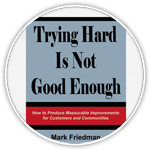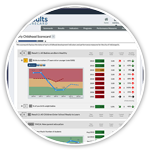The “regular” method presented in on pages 54 to 56 of “Trying Hard Is Not Good Enough” involves rating each potential measure “high, medium or low” on three criteria: Communication Power, Proxy Power and Data Power. A simpler method for doing this mirrors the selection steps in choosing performance measures in steps 4 and 5 of Appendix G.
For each potential indicator, identify those for which you currently have good data. Put a circle next to these measures. Then ask “If you had to stand up in a public place and explain to your neighbors what you mean by (the result in question, e.g. Healthy Children), and could only use one of the measures with a circle next to it, which one would you use?” Then ask, “What if you could have a second…. a third?” Through this method you identify the top three indicators for any given result. This method is exactly equivalent to the Communication/Proxy/Data method for this reason. By first identifying the measures for which you have good data, you address Data Power. In asking which one people would use in a public place, it forces them to consider Communication and Proxy power together, namely, which measures are most powerful that people will understand? This method is faster and easier to use than the process of rating each measure.
This method also sets up the creation of a Data Development Agenda. Again, paralleling the performance process, ask “If we could buy one of the measures for which we don’t have data, which would be the first we would buy?” “What if we could buy a second?” Through this process you can create a prioritized list of needed new and better data.



